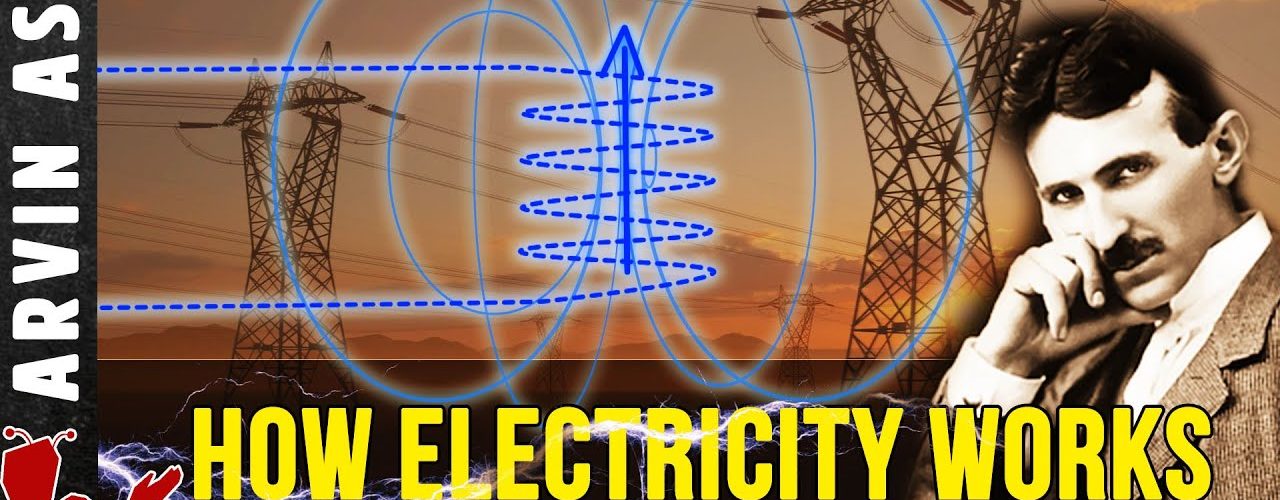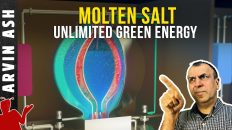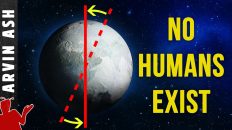The science of Nikola Tesla! How Electricity works: AC vs DC
Genius of Nikola Tesla: What is electricity? How does it work? AC vs DC
Imagine a world where “with a device we can put in our vest pocket…through television and telephony we can see and hear each other as if we were face to face,” where “motion pictures can be transmitted wirelessly,” where “automobile carriages …can perform operations involving…judgement.”
And where “electricity is generated centrally and transmitted over vast distances to provide power to homes and factories.” – that’s the world we live in today, and perhaps take for granted.
But there was a man who imagined these impossible technologies more than a hundred years ago. He along with Thomas Edison have arguably had more of an impact on the modern technologically advanced lifestyle we enjoy today than any other scientists past or present.
That man is of course Nikola Tesla. Yet, this giant of imagination and innovation died nearly penniless, and almost forgotten. But, there is no doubt that history has posthumously rewarded him with the accolades and recognition that he richly deserves.
Perhaps Tesla’s biggest contribution to the world was his innovations in alternating current technology, that allowed electrical power transmission over long distances, and the invention of the AC motor that allowed this AC power to be used by factories and businesses.
The adoption of this technology was an uphill battle because Thomas Edison’s DC or direct current systems had been the standard early on.
Edison tried desperately to convince the world to go with DC and even staged an electrocution of a convicted criminal by AC current, to show the public how dangerous AC technology was. But AC eventually won out, because the underlying truth about the superiority of any technology lies in the science. And science has an objective truth that is difficult to silence.
What does science have to say about Edison’s DC vs. Tesla’s AC technology? In order to explain this, I am also going to explain how electricity works in general, using a simpler analogy of electricity flowing through a wire, you might find more relatable, and that is water through a garden hose.
Nikola Tesla was born in what is today Croatia. His father wanted him to be priest, but as a teenager, Nikola was fascinated by math and physics, and instead became an engineer.
At 29, he immigrated to the United states with 4 cents in his pocket, but he had a recommendation letter that got him a job redesigning direct current generators at one of Edison’s factories in New York City.
Tesla only lasted about a year on this job partly because his ideas on alternating current technology conflicted with Edison’s DC.
What is AC and DC anyway? And why is one superior to the other?
To understand this, you have to understand some basics about electricity. So, what is electricity?
All materials are made of atoms. Atoms have a positively charged nucleus and negatively charged electrons surrounding the nucleus. These electrons are bound to the nucleus due to their electromagnetic attraction to the oppositely charged nucleus.
But electrons in the outermost shell of the atom, called the valence shell, can sometime become free due to external forces. These electrons that escape from the valence shell are called free electrons. And they can move from one atom to another. This is what can cause a movement of charge. And this flow of electric charge is what electricity is all about.
Materials that allow many electrons to move freely are called conductors. And materials that don’t allow much free movement of electrons are called insulators.
So for example, if you look at copper, you will notice that it has one electron in its outermost or valence shell. This can quite readily become a free electron. That’s why copper is a great conductor. If we force this electron to move, we create electricity.
An electrical current is the flow of free electrons from one atom to another.
There are three concepts that you should understand, if you want to understand electricity. And these are current, voltage, and resistance.
All three are connected, if you change one, the others will change too. The relationship between these three properties is described by Ohm’s law, named after German physicist Georg Ohm. (Gee org Ohm):
Voltage = Current x Resistance
These are not easy to visualize because you can’t see them. So we will use the analogy of electricity as water.
Think of a water tank, with a hose attached to the bottom.
Current, measured in amps, is the rate at which the charges flow. It is analogous to the rate of flow of the water at the end of the hose.
Voltage, measured in volts, is the force required to make current flow. It is analogous to the water pressure at the end of the hose.
Resistance is a material’s tendency to resist the flow of charge. Think of the resistance as the diameter of the hose. The smaller the hose, the higher the resistance.
So if you have two tanks with the same amount of water, but one has a smaller hose than the other, or higher resistance, it will have a lower flow, given the same pressure.
Similarly, a circuit with higher resistance, at constant voltage, will have a lower current.
But, if water flow from the tank is constant, but the diameter is smaller, than pressure will increase.
Similarly, if current is constant in a circuit, then a higher resistance will result in higher voltage.
How does this water analogy relate to direct current and alternating current?
DC is similar to the normal flow of water through the hose that we are seeing here. The water flows in one direction. In this scenario, current flows at a constant rate over time: This was championed by Thomas Edison in the famous current wars that pit him against Nikola Tesla, who championed AC.
AC is like the water flowing back and forth within the hose 50 or 60 times per second, This is called the frequency and is designated as either 50 Hertz (50Hz) or 60 Hertz (60Hz), and depends on the electric system of the country.
This is where the water analogy is not so great, because water doesn’t flow back and forth in a hose. But alternating current is easily created by industrial electric generators, and
is now the world standard for transmission of electricity.
Why did this technology win out over DC, even though Thomas Edison, one of the most famous and powerful men of the 19th century tried his best to disparage it.
The answer has to do with efficiency and power delivery. Power is like the volume or amount of water coming out of the hose. The reason electricity is generated is to send power to homes and factories.
The mathematical formula for power equals the current times voltage. The greater the current and the greater the voltage in the transmission lines, the more power that is available to be delivered.
P = I x V
Using the formula P equals I V, you can see that the same amount of power can be transmitted either at high current and low voltage, or low current and high voltage. But one is better than the other.
You see, the power cables used to transmit electricity have a certain amount of resistance per meter of distance. The longer this cable is, the more resistance there is in the power line.
And anytime you pass a current through resistance, you create heat, given by Joule’s equation for electric heat, where heat is equal to current squared times the resistance:
Heat = I^2 R
Heat is wasted energy, because it essentially robs the grid of useful power that is not delivered to homes and business, but is lost to the air. So it is crucial to minimize this heat, otherwise much of the power that you want to deliver is going to get wasted.
Since I is P over V from our power equation, if we substitute that back into the heat equation. We see that Heat equals Power squared times resistance R, divided by voltage V squared.
You can see now that in order to reduce heat, we want to MAXIMIZE voltage V to deliver the same amount of power P,
because for any given power and resistance, the higher the voltage that we can create in the circuit, the lower the heat loss we will have while transmitting electricity.
In modern electric power grids, electricity is routinely transmitted for hundreds of kilometers at hundreds of thousands of volts.
But voltage can not be this high when it arrives at your home because it would be very dangerous, and could easily electrocute you. So, it has to be stepped down before it gets to your house. This is done via a transformer which steps the voltage from hundreds of thousands of volts to typically between 110 to 240 volts, which is the voltage of electrical outlets in most homes around the world.
This stepping up and stepping down of voltage is where alternating current shines in comparison to direct current.
Direct current cannot be easily transformed from low voltage to high voltage and visa versa. But this is quite easy to do with alternating current. And here’s the reason why:
When alternating current passes through a coil, it produces a constantly changing magnetic flux, per Maxwell’s equations, that say that changing electric fields create magnetic fields. If we put a loop or ring of iron through the coil, it can concentrate the changing magnetic flux to within the ring.
Now if we wind another coil around the other side of this ring, we can create electricity and induce voltage within the new coil, because again according to Maxwell’s equations a changing magnetic field creates a circulating electric field.
It so happens that the voltage we create in the second coil is proportional to the number of loops or turns we place around the iron ring. Using this method we can create voltage that is much higher in the second loop than the original voltage in the first loop.
This is very roughly how a transformer works, and this method is used to step up the voltage for transmission over vast distances, to minimize energy loss.
And we can use this same method to step down the voltage to a safer level, before it is delivered to your home, by simply making a smaller number of turns in the step down transformer.
But as you can see, transformers like this require a time-varying voltage to function, and since direct current is constant, and only alternating current is time-varying, transformers like these only work with AC electricity.
In Edison and Tesla’s time, there was no easy way to transform voltage with direct current. And this is the primary reason Tesla’s AC won out over Edison’s DC in the early era of electrical transmission.
You might ask, can devices work equally well with DC or AC current? Many devices—like light bulbs—only require that the electrons move. They don’t care if the electrons flow through the wire or simply move back-and-forth. So a light bulb, for example, can typically be used with either AC or DC electricity.
The fact that that alternating current powers most of the modern industrial world made Tesla the winner of the current wars.
But as in most wars, there are always two sides to the story. Was DC really a losing concept long term? Not really. You have to remember that most high tech appliances today that are powered batteries, like your laptop, cell phone, and iPad are all powered by direct current. And these appliances need an adaptor to convert AC current from your electrical outlet to the DC current that they can use.
In addition, in the late 20th century, engineers figured out a way to transmit electricity using high voltage direct current, or HVDC. It turns out HVDC is more efficient than high voltage AC for transmitting electricity over extremely large distances of 1000 km or more. This is because smaller cheaper lines can be used to transmit the same amount of power using DC, and there is less induction loss because no changing magnetic field exists with DC unlike with AC. But the cost of DC transformers is huge, 10’s of million of dollars vs. only thousands of dollars for AC transformers. So HVDC is only cost effective for very long transmission lines.
Edison’s place in history as an inventor and electrician is secure. But in many ways Tesla went even further. He envisioned fluorescent lights, technology of the radio, and remote control. But he was an eccentric. Because along with genius ideas like these, he also spoke about crazy things like splitting the earth in half, and creating a death ray that could destroy thousands of airplanes.
Scientists didn’t know what to believe in his time, and were slow to praise him. Tesla he did not get his due acclaim until after his death. But I don’t think anyone disputes today that he was one of the most forward thinking, and dynamic visionaries that ever lived.
If you’d like to learn more about inventions like Tesla’s that changed the world, there is a superb course available at Great Courses plus: http://ow.ly/u8lK30r8uzZ







